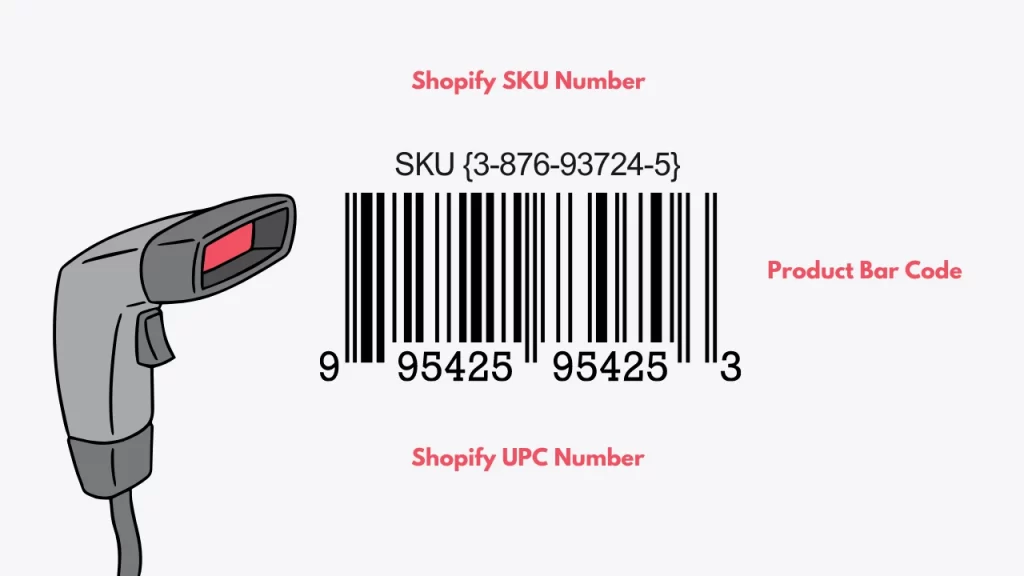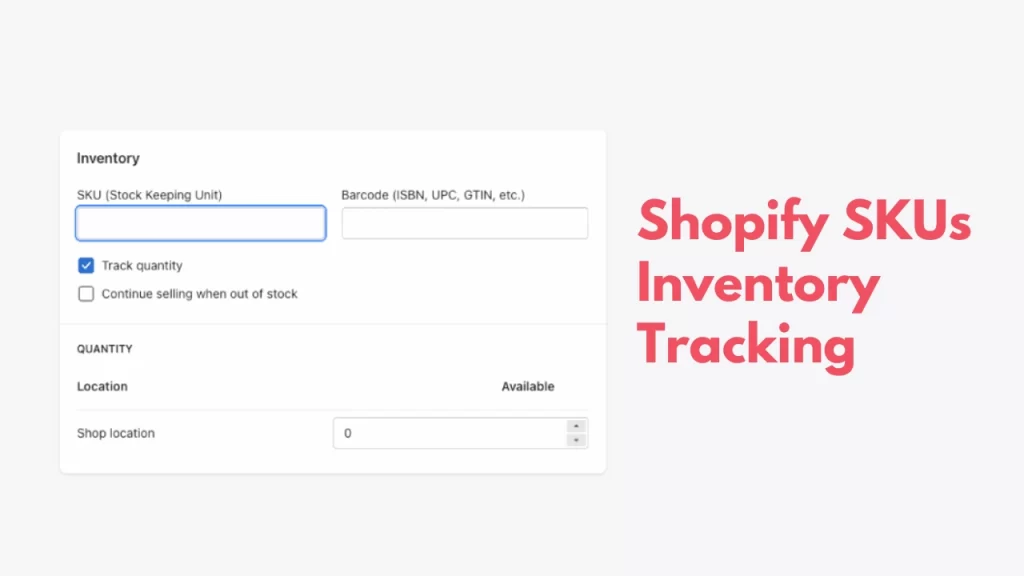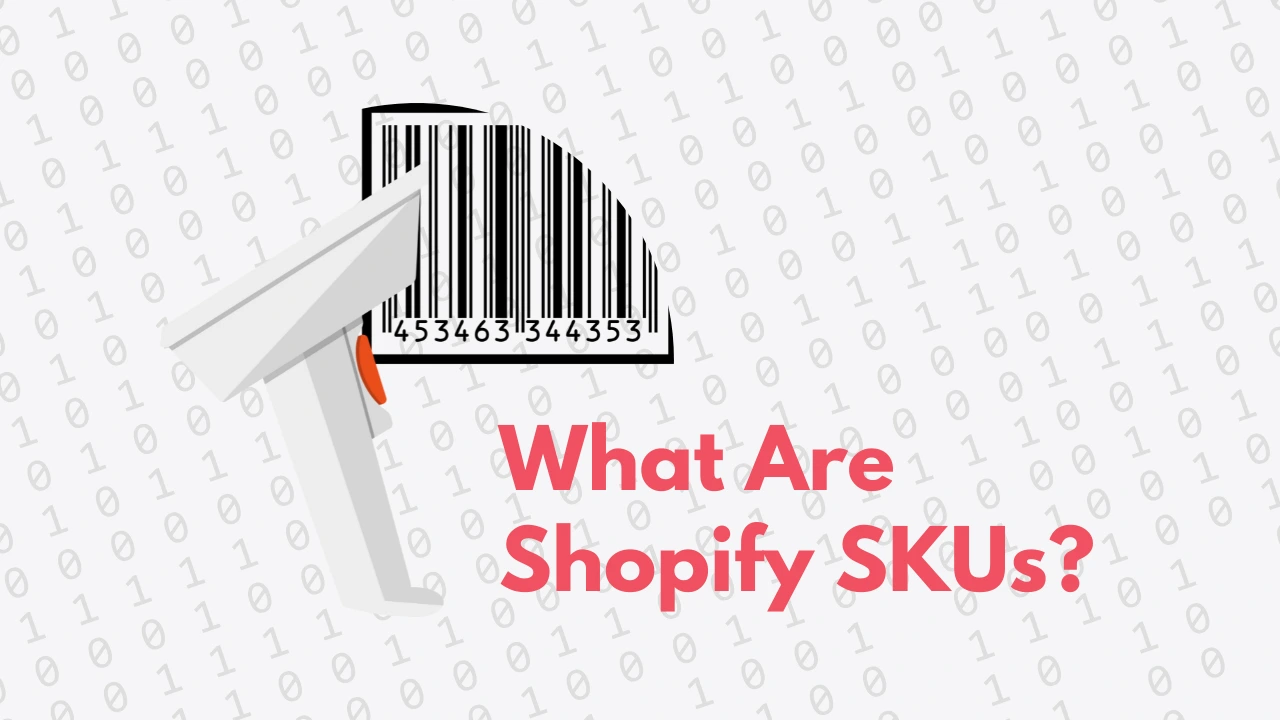“Shopify SKU: A unique alphanumeric code that helps identify various products on the store.”
The e-commerce market reflects how inventory management yields higher revenues. Managing products efficiently is crucial for a successful Shopify Business. One key aspect of this process is understanding and utilizing Shopify SKU.
In this Shopify SKU 101 Guide, you’ll see what SKU codes actually look like.
Are these bar codes? Scannable QR codes? Or something else?
Let’s uncover the role SKUs play in streamlining inventory management. This definitive guide explores how SKUs not only help businesses but also enhance the customer experience. We will go over the meaning of SKUs in detail and their significance.
On we go!
What is a Shopify SKU Code?
Shopify SKU (Stock Keeping Unit) is a unique identifier for products.
It is assigned to each distinct product on your Shopify Store. It is like a record that helps in managing store inventory. Basically, these SKUs serve as a product’s fingerprint.
We discussed the importance of creating unique discount codes in our guide Shopify Discount Codes. They help in the sales campaign tracking. Much like discount codes, Shopify SKU Codes allow inventory tracking. They are essential to maintain order within a complex inventory system. Your Shopify SKUs contain key information, facilitating easy and accurate tracking.
Let’s say you only have 10 products in your store.
Even then, managing inventory for these products will not be a piece of cake. Each of these products may have at least three different color variations. Besides that, different sizes such as small, medium, large, and XL raise your inventory.
10 Products X 3 Color Options X 4 Size Options
=120 Product Variations in Inventory
So your Shopify Store will have at least 120 different product variations.
And we haven’t even accounted for any personalized or Customizable Shopify Products yet! ????
Just the basic product variations can make inventory management tough. Keeping track of products and their subsequent variations is no joke! Shopify SKU allows businesses to manage inventory better.
What Problems Do Shopify SKU Systems Solve?
With multiple product options come shipping issues, and whatnot…
E-commerce businesses know it better. Oftentimes, customers get the wrong order or the wrong sizes.
Other inventory-related problems can include:
- Shopify Order Mixing
- Wrong Order Shipping
- Inventory Management
- Stockouts of in-demand Products
Shopify SKU Systems help businesses solve all these problems.
With SKUs and many other tactics, our Shopify Maintenance Experts harmonize your inventory like notes in a symphony.
Components of Shopify SKU Code
The components of a Shopify SKU typically consist of alphanumeric characters.
These characters convey specific information about a product. SKUs include details like product type, color, size, and other relevant attributes. Businesses can quickly gather insights about their inventory levels by decoding an SKU.

And when it comes to placement of the Shopify SKU Code, the best place is the UPC Barcode.
Every product has a Bar Code and a unique UPC Number. Placing the unique SKU Code on top of the bar makes it easy to locate for everyone. Now we have laid a lot of emphasis on unique SKU Codes in the article. Even though Shopify doesn’t ban duplicate SKUs, having unique SKUs is the best.
But the question is, how far do stores need to go for distinctive codes?
Overcomplicating Shopify SKU Codes to make them more unique is a common mistake. While detailed SKUs are beneficial, overly complex structures lead to confusion. And nobody likes confusion! Neither your customers nor the staff. We make sure our clients steer clear of any SKU Code related issues.
Shopify SEO Experts recommend striving for a balance between descriptiveness and simplicity.
Besides that, regularly maintain and update your SKUs. This helps businesses ensure they accurately reflect their inventory. A neglected Shopify SKU maintenance makes the system obsolete and counterproductive. It’s like letting the digital dust bunnies take over – not a pretty sight!
Significance of Shopify SKU Inventory Tracking
What if consumers arrive at your store only to discover that the product they sought is out of stock?
They are going to leave disappointed. And you will lose business to the competitors. Shopify SKU Codes allow for precise tracking of inventory levels. In the steadfast e-commerce world, timely restocking the raw materials for high-demand items is the best way to ensure consistent sales.
Shopify SKUs reduce the possibility of running out of the store’s finest items. Isn’t that a compelling reason to create SKU Numbers for your products? Well, we are going to give you some more reasons to think about Shopify SKU Systems!

#1: Efficient Inventory Management
Didn’t we just discuss how SKUs facilitate inventory tracking and management?
Well yes, but it also makes managing the store products easier. Shopify SKUs enable organized categorization of your Shopify products. Since all the products have unique codes arranged as per attributes, it simplifies inventory tracking processes. For instance, here is what a series of SKU Codes for a product category might look like.
PAH-180
PBJ-181
PFQ-182
PKR-183
PWY-184
All the products after “180” may describe variations of the shades of blue. They could also be the indicators for the brand numbers on a Shopify Dropshipping Store. Basically, EASY CATEGORIZATION????. Check out our guide How to Fulfill Dropship Orders on Shopify to know more about it. Maybe you could start one too!
Businesses can thus streamline stock counting activities and automate inventory updates easily.
#2: Data Analysis and Product Insights
Effective utilization of data is at the heart of informed business decisions. Shopify SKU System allows businesses to delve into data analysis and reporting. These key insights are a potent advantage that supports various crucial aspects. Here’s how data helps businesses.
- Sales Forecasting: Shopify SKUs empower accurate sales forecasting, granting businesses the foresight to plan inventory. This, also helps them allocate resources judiciously.
- Product Pricing: Shopify SKUs unravel the threads of product popularity! By keeping track of the product categories that are getting sold out, businesses can ascertain the performance of products – from high-flying stars to underwhelming ones.
Armed with this knowledge, strategic pricing, and marketing decisions can be fine-tuned!
This results in maximizing revenue streams for some of the best-performing Shopify Stores.
Crux
Using Shopify SKU Codes is a must for efficient inventory management.
Such product data translates to well-optimized stock levels. Shopify Experts consider it a driving force for profitability. We can not emphasize how SKUs help businesses decipher the past and present of the store. It is time for you to chart a course towards successful product management with Shopify SKUs.
We hope this article helped you understand how SKUs help with accurate order fulfillment.
Creating and implementing effective SKUs can truly enhance customer’s experiences, and streamline operations. Want to learn the process? Read our guide on How to Create an SKU in Shopify.
FAQs
Why is the Shopify SKU System important?
The Shopify SKU System is crucial for online businesses. It facilitates organized inventory management. Moreover, SKUs also ensure accurate order fulfillment for Shopify customers.
How to create effective Shopify SKUs?
You can create effective SKUs by using descriptive product names. Incorporating different product attributes like brand, price, size, and color makes SKUs unique.
What is the significance of consistent SKUs across channels?
Consistent SKUs across channels prevent confusion among customers. Since SKUs enhance tracking and inventory management, it reduce the chances of any human errors by the staff.











